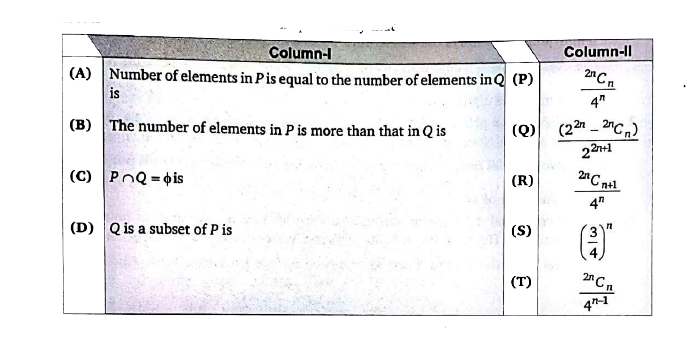A is a set containing n elements, A subset P (may be void also) is selected at random from set A and the set A is then reconstructed by replacing the elements of P. A subset Q (may be void also) of A is again chosen at random. The probability that

2nCn22n
12nCn
1.3.5….(2n−1)2n.,n!
3n4n
The correct Answer is:A, C
Step by step video solution for A is a set containing n elements, A subset P (may be void also) is selected at random from set A and the set A is then reconstructed by replacing the elements of P. A subset Q (may be void also) of A is again chosen at random. The probability that by Maths experts to help you in doubts & scoring excellent marks in Class 12 exams.
Updated on:21/07/2023Topper's Solved these Questions
- PROBABILITYBOOK - VMC MODULES ENGLISHCHAPTER - PROBABILITYEXERCISE - LEVEL - 2
49 Videos
- PROBABILITYBOOK - VMC MODULES ENGLISHCHAPTER - PROBABILITYEXERCISE - NUMERICAL VALUE TYPE FOR JEE MAIN
15 Videos
- PROBABILITYBOOK - VMC MODULES ENGLISHCHAPTER - PROBABILITYEXERCISE - JEE ADVANCED (ARCHIVE)
102 Videos
- PERMUTATION & COMBINATIONBOOK - VMC MODULES ENGLISHCHAPTER - PERMUTATION & COMBINATIONEXERCISE - JEE ARCHIVE
50 Videos
- PROPERTIES OF TRIANGLEBOOK - VMC MODULES ENGLISHCHAPTER - PROPERTIES OF TRIANGLEEXERCISE - JEE Advanced (Archive)
50 Videos
Similar Questions
A is a set containing n elements. A subset P of A is chosen at random. The set A is reconstructed by replacing the elements of P. A subset Q is again chosen at random. The probability that P =Q, is
View SolutionA is a set containing n elements. A subset P of A is chosen at random. The set A is reconstructed by replacing the elements of P. A subset Q is again chosen at random. The Probability that P∪Q=A, is
View SolutionA is a set having n elements. A subset P of A is chosen at random. The set A is reconstructed by replacing the elements of A. A subset Q of A is again chosen at random. Find the probability that P and Q have no common elements.
View SolutionLet A be a set containing elements. A subset P of the set A is chosen at random. The set A is reconstructed by replacing the elements of P, and another subset Q of A is chosen at random. The probability that P∩Q contains exactly m(m<n) elements, is
View SolutionA is a set containing n elements. A subset P of A is chosen at random. The set A is reconstructed by replacing the elements of P. A subset Q is again chosen at random. The probability that Q contains just one element more than P, is
View SolutionA is a set containing n elements. A subset P of A is chosen at random. The set A is reconstructed by replacing the elements of P. A subset Q is again chosen at random. The Probability that P and Q have equal number of elements, is
View SolutionA is a set containing n elements . A subet P of
A is chosen at random. The set A is reconstructed by replacing the
elements of P.A subet Q is again chosen at random. The number of
ways of selecting P and Q, is .
View SolutionA is a set containing n elements. A subset P of A is chosen at random. The set A is reconstructed by replacing the elements of P. A subset Q is again chosen at random. The Probability that P∩Q contain just one element, is
View SolutionA is a set containing n elements. A subset P of A is chosen at random. The set A is reconstructed by replacing the elements of P. A subset Q is again chosen at random. The Probability that P∪Q contain just one element, is
View SolutionP is a set containing n elements . A subset A of P is chosen and the set P is reconstructed by replacing the element of A. B such that A and B have no common elements, is
View Solution
